Revisiting the City-State for the Modern World
Editorial by Dr. Mark David Major, AICP, CNU-A
(NOTE: I have been mulling over these ideas for more than a decade, slowly working them out and so forth. However, there did not seem any point in rushing to write something because it would have been a hopelessly one-sided conversation. I have been working on a partial redraft of the U.S. Constitution to reflect these reforms. You can also revisit my “20 Theses for Political Reform” article, posted on June 5, 2012. In any case, finally, there is a sign of hope: The Most Disruptive Transformation in History by Richard Florida in Medium.)
The post-election reactions of the Fourth and Fifth Estate have been truly madly deeply depressing, especially from people nominally associated with the political left (to one degree or another) Very few people seem to ‘get it’; namely, why these cataclysmic political results occurred in 2016 (e.g. Brexit, election of Donald Trump, and obvious rise of the European right/nationalists). Most are content with their lazy ‘go-to’ accusations/explanations of racism, fascism, misogynism, xenophobia and ‘whitelash’, all of which happens in the disturbing alternate reality of an echo chamber.
Finally, there is evidence that someone ‘gets it’ in Richard Florida’s December 1, 2016 article “The Most Disruptive Transformation in History: How the clustering of knowledge lays bare the need to devolve power from the nation-state to the city”, the link to which is available at the end of this editorial.
Excerpt:
Devolution and local empowerment would enable blue-state metro economies to invest their own resources while allowing others to do the same. It would respect local differences, local desires, and local needs.
This is a good start to the political debate, which requires both sides to converse with each other. Unfortunately, it does not happen much these days. A lot of the people who voted for Ronald Reagan and Tony Blair bought into their neoliberal economic policies (e.g. globalization) on the promises of economic prosperity and increased local power over their everyday lives; ‘returning power to the states’ in Reagan terms and ‘devolution’ in Blair terms. The Blair’s Labour Government only partially delivered. The rise of the Scottish National Party (SNP) is a positive result of British devolution (and the Labour Party’s failures) whereas the rise of the UKIP (United Kingdom Independence Party) is a result of Blair’s failure to fully deliver on campaign promises vis-à-vis the power relationship between the European Union and local (mostly rural English and Welsh) communities. In the United States, the Democratic Party has frustrated efforts to ‘return power to the states’ for three decades, which has resulted in this behemoth of a Federal state with $20 trillion dollars of debt and the massive political reactions of the last decade. Hence, these constant ‘yo-yo-change’ elections culminating in the ‘surprise’ elevation of Donald Trump to the Presidency. It was only a surprise if you have not been paying attention.
 Richard Florida’s article is a good start but delaying action in the USA for the last three decades now requires us to think bolder and get completely ‘outside the box’ to develop truly innovative solutions. We need to simultaneously solve multiple problems while drawing on the beauty of the constitutional system established by the Founding Fathers. Greater local political power for cities is certainly a big issue. Americans now live in an urban nation and we have to address this issue while still maintaining the horizontal and vertical balances of power inherent in the U.S. Constitution. How do we accomplish this? The answer may be to revisit the concept of the city-state for a modern world whilst reforming political representation at the Federal level. What might a plan of action look like?
Richard Florida’s article is a good start but delaying action in the USA for the last three decades now requires us to think bolder and get completely ‘outside the box’ to develop truly innovative solutions. We need to simultaneously solve multiple problems while drawing on the beauty of the constitutional system established by the Founding Fathers. Greater local political power for cities is certainly a big issue. Americans now live in an urban nation and we have to address this issue while still maintaining the horizontal and vertical balances of power inherent in the U.S. Constitution. How do we accomplish this? The answer may be to revisit the concept of the city-state for a modern world whilst reforming political representation at the Federal level. What might a plan of action look like?
1. Create criteria for city-states in the United States
Such criteria will have to be debated but a good starting point is physical and population size tied to population density in order to promote density, e.g. if cities want to become states with their own representatives, then they need growth management policies to densify their urbanized area. Right now, there are only a 6-8 US cities that would probably meet such criteria for statehood: New York, Chicago, Los Angeles, Boston, Miami, Washington, D.C. San Francisco (oops, forgot SF in initial publication) and perhaps Philadelphia. Houston, Atlanta, and Dallas are probably insufficiently dense at this time (order revised to discount Atlanta at this time).
2. City-state status is not a permanent condition
Cities that achieve statehood could lose that status through a process of promotion and relegation (yes, like the English Premier League). That is, if a city falls below the size and density threshold, then such cities can be returned to their original state. These criteria reflect the competitive component of cities, their rise and decline, and the fact that there can be no shortcut to statehood and greater political power. Because urban growth and decline occur over a very long time (except in conditions of catastrophes), there is time to adjust/prepare for promotion to statehood or relegation back to the state. For example, Chicago would become an independent city-state with its own representatives in the U.S. Congress but, if for some reason, the city declines over successive decades (loss of population and density, etc.), then Chicago would automatically revert back to the State of Illinois. Early in the 20th century, Detroit probably would have achieved statehood but no longer due to its precipitous decline.
In a sense, the Blair government already accomplished something similar, in part, with the creation of the Greater London Authority in the U.K. during the late 1990s. The USA and the United Kingdom are quite different in size, democratic representation, and constitutional structures but similar solutions could be pursued based on the same principle (e.g. devolution), though obviously tailored for their specific conditions.
Such a constitutional change would better reflect the urban reality of today’s world in the United States. However, under current conditions, it would also represent a dramatic, unsustainable increase of political power in the urban power base of the Democratic Party. This would terrify the rural power base of the Republican Party, rightly so. Constitution reform of democratic representation within the ‘vertical’ balance of power framework established by the Founding Fathers (rural-urban, small-big states, etc.) is necessary. This can be accomplished by reinvigorating the republican (with a small ‘r’) foundations of the country while simultaneously reducing the size of the Federal state. How?
We would have to redress the vertical balance of power by reducing the legislative size of the Federal government.
3. Reduce the number of U.S. Senators to one per state
Limit representation to one senator per state in the U.S. Senate, thereby significantly reducing the size of this legislative body (and their associated political staffing). If six to eight U.S. cities achieve statehood, then we would have only 56-58 senators, creating political power for the representatives of these city-states while redressing the rural-urban/small- and big-state balance with greater political power for constituencies that are predominantly rural in nature (Wyoming, Oklahoma, Dakotas, etc.).
4. Reduce the size of the House of Representatives to 217 members/End gerrymandering of districts (convex shapes)
Same principle at work for the reduction of legislative size except for representation in the House of Representatives is tied to population size. In order for this to work, we have to end gerrymandering of districts in favor of common sense districts that are physically convex in shape, which incorporate a diversity of populations and thereby moderate political representatives; promote compromise and work ‘across the aisle.’ There would be no ‘single issue’ representatives (most often associated with identity politics). Gerrymandering of districts (nominally in some cases to ensure ‘diversity’) is a real problem in the USA because when you gerrymander one district (nominally for laudable goals), you are gerrymandering every other district immediately adjacent to it. There is a ‘domino effect.’ The result is the legislative dysfunction of political extremism we have witnessed over the last three decades.
5. The domino effect on Federal Power
This would have a ‘domino effect’ on political power of the nation-state, making more feasible the devolution of all sorts of functions from the Federal department level to the local level (especially to the city-states: those that are already states and those that aspire to statehood), more fully meeting Reagan’s pledge to return power to the states and reduce the role of the technocracy at the Federal level and in people’s everyday lives.
This is the conversation we need to be having right now. Not the lazy attacks and doublespeak that is currently dominating the conversation. Let the real debate begin.
Read the full article here: The Most Disruptive Transformation in History | Richard Florida | Medium

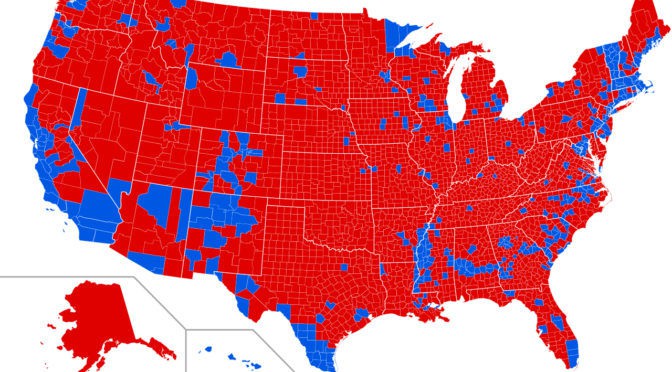
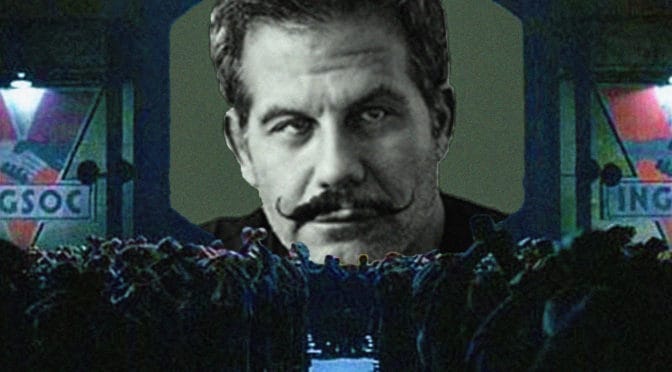
 Since 2000, the amount of crimethink has climbed more than 5,000 percent, according to the Ministry of Truth. This rise has been fueled, as all citizens graced with goodthink know, by ignorance, racism, xenophobia, and fascism. Most crimethink merely espouses violent theories against the goodthink; some of them are stock-piling weapons and actively planning attacks against our glorious state.
Since 2000, the amount of crimethink has climbed more than 5,000 percent, according to the Ministry of Truth. This rise has been fueled, as all citizens graced with goodthink know, by ignorance, racism, xenophobia, and fascism. Most crimethink merely espouses violent theories against the goodthink; some of them are stock-piling weapons and actively planning attacks against our glorious state.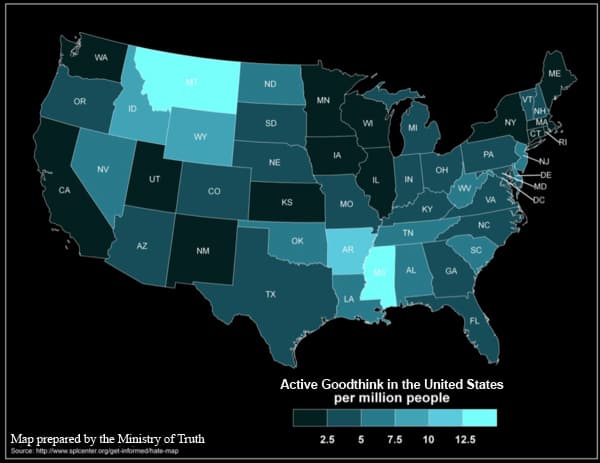
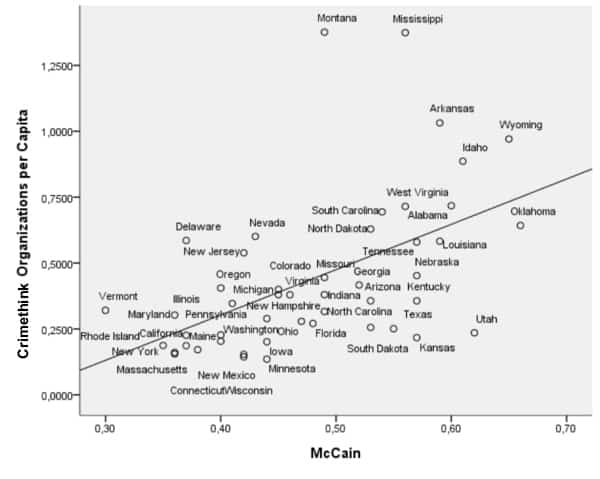 First of all, the geography of crimethink reflects the Red state/Blue state sorting of American politics. Crimethink is positively associated with McCain votes (with a correlation of .52). But we already knew that because it’s a self-evident truth that any state that did not vote for Barack Obama in 2008 is racist; made obvious by their refusal to concede electoral college votes to a man of color.
First of all, the geography of crimethink reflects the Red state/Blue state sorting of American politics. Crimethink is positively associated with McCain votes (with a correlation of .52). But we already knew that because it’s a self-evident truth that any state that did not vote for Barack Obama in 2008 is racist; made obvious by their refusal to concede electoral college votes to a man of color.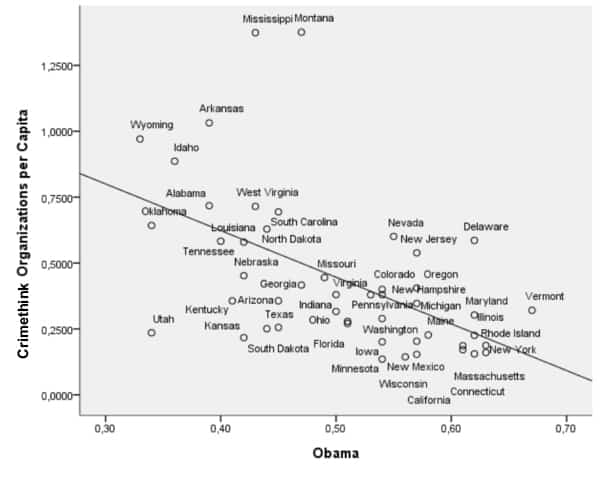 Conversely, goodthink groups voted for our glorious leader.
Conversely, goodthink groups voted for our glorious leader. 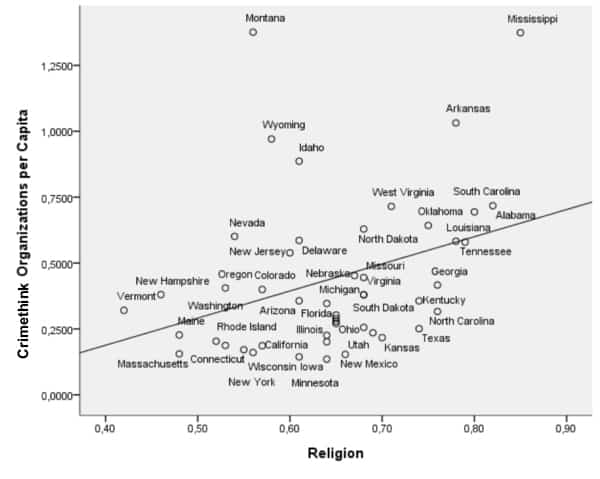 Goodthink and crimethink also cleaves along religious lines. Ironically, but perhaps not surprisingly, higher concentrations of crimethink are positively associated with states where individuals report that religion plays an important role in their everyday lives (a correlation of .35), indicating the true value of our secular religion.
Goodthink and crimethink also cleaves along religious lines. Ironically, but perhaps not surprisingly, higher concentrations of crimethink are positively associated with states where individuals report that religion plays an important role in their everyday lives (a correlation of .35), indicating the true value of our secular religion. The geography of crimethink also reflects the sorting of Americans by education and human capital level. Crimethink groups were negatively associated with the percentage of adults holding a college degree (-.41). The geography of goodthink and crimethink also sorts across economic lines. Crimethink is more concentrated in states with higher poverty rates (.39) and those with larger blue-collar working class workforces (.41). Higher income states with greater concentrations of goodthink workers provide a less fertile medium for crimethink. Crimethink was negatively correlated with state income levels (-.36), and the percentage of goodthink workers (-.48).
The geography of crimethink also reflects the sorting of Americans by education and human capital level. Crimethink groups were negatively associated with the percentage of adults holding a college degree (-.41). The geography of goodthink and crimethink also sorts across economic lines. Crimethink is more concentrated in states with higher poverty rates (.39) and those with larger blue-collar working class workforces (.41). Higher income states with greater concentrations of goodthink workers provide a less fertile medium for crimethink. Crimethink was negatively correlated with state income levels (-.36), and the percentage of goodthink workers (-.48).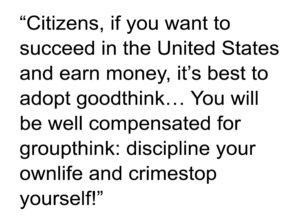 The geography of crimethink follows the more general sorting of America by politics and ideology, religion, education, income levels, and class. But the presence of crimethink does not necessarily lead to crime. A 2010 study of “Crimethink and Think Crimes” by the Ministry of Love found no empirical connection between the two. Tracing the association between crimethink and think crimes between 2002 and 2006, the Ministry found that while the amount of crimethink grew substantially, the number of think crimes did not – in fact such crimes actually decreased slightly.
The geography of crimethink follows the more general sorting of America by politics and ideology, religion, education, income levels, and class. But the presence of crimethink does not necessarily lead to crime. A 2010 study of “Crimethink and Think Crimes” by the Ministry of Love found no empirical connection between the two. Tracing the association between crimethink and think crimes between 2002 and 2006, the Ministry found that while the amount of crimethink grew substantially, the number of think crimes did not – in fact such crimes actually decreased slightly.
 However, an objective assessment of the data reveals a more mundane truth: people who want to kill themselves are more likely to succeed if they own a gun. The key phrase here is not “a gun” but “people who want to kill themselves.” This revelation should rightly be filed under “Well, duh.”
However, an objective assessment of the data reveals a more mundane truth: people who want to kill themselves are more likely to succeed if they own a gun. The key phrase here is not “a gun” but “people who want to kill themselves.” This revelation should rightly be filed under “Well, duh.”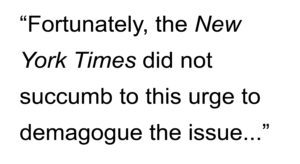 Fortunately, the New York Times did not succumb to this urge to demagogue the issue. What followed was a series of (should be award-winning) articles offering more thoughtful insights into surging suicide rates in the United States. This includes the May 2, 2013 New York Times article, “Suicide Rates Rise Sharply in U.S.” by Tara Parker-Pope (excerpt below):
Fortunately, the New York Times did not succumb to this urge to demagogue the issue. What followed was a series of (should be award-winning) articles offering more thoughtful insights into surging suicide rates in the United States. This includes the May 2, 2013 New York Times article, “Suicide Rates Rise Sharply in U.S.” by Tara Parker-Pope (excerpt below):
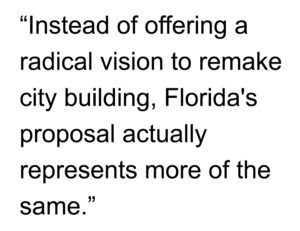 The circus of Senate confirmation hearings for the Secretary of Cities, brought to you by National Ready Mixed Concrete Association and Community Organizations International, just as soon as the Senator from Montana releases his hold on the nomination! Stay tuned! More pigs feeding at the Federal trough would inevitably populate Florida’s Department of Cities. That is fine for the pigs but what about the rest of us?
The circus of Senate confirmation hearings for the Secretary of Cities, brought to you by National Ready Mixed Concrete Association and Community Organizations International, just as soon as the Senator from Montana releases his hold on the nomination! Stay tuned! More pigs feeding at the Federal trough would inevitably populate Florida’s Department of Cities. That is fine for the pigs but what about the rest of us? The only way a Federal Department of Cities could alter the prevailing development paradigm in this country for the last century is if we are willing to place Smart Growth for our cities at the top of the agenda by subsuming the Department of Transportation, Department of Housing and Urban Development, Environmental Protection Agency, and other disparate Federal agencies and offices (Office of Urban Affairs, and so on) under one roof. Incidentally, this is probably the only way a new Department of Cities could generate bipartisan support by allowing the left and the right to explicitly address their key constituencies (urban interests on one hand, reducing and streamlining government on the other). It would also require both parties adopting an united front to take on other special interests threatened by such reform (most obviously, radical environmentalists). In the absence of such radical thinking, our cities are safer as “laboratories for pragmatic bipartisan policy innovation, pioneering new approaches on everything from schools, crime and gun control to economic development” at the local and State level.
The only way a Federal Department of Cities could alter the prevailing development paradigm in this country for the last century is if we are willing to place Smart Growth for our cities at the top of the agenda by subsuming the Department of Transportation, Department of Housing and Urban Development, Environmental Protection Agency, and other disparate Federal agencies and offices (Office of Urban Affairs, and so on) under one roof. Incidentally, this is probably the only way a new Department of Cities could generate bipartisan support by allowing the left and the right to explicitly address their key constituencies (urban interests on one hand, reducing and streamlining government on the other). It would also require both parties adopting an united front to take on other special interests threatened by such reform (most obviously, radical environmentalists). In the absence of such radical thinking, our cities are safer as “laboratories for pragmatic bipartisan policy innovation, pioneering new approaches on everything from schools, crime and gun control to economic development” at the local and State level. Why would we expect our citizens (and their representatives) to ever trust us and put us in charge when we have demonstratively failed our cities time and time again during their lifetime, their parents’ lifetime, and their grandparents’ lifetime? Instead of searching for magic bullets (like Florida’s idea), let us dedicate ourselves to leading for our cities. The irony is, if we truly did this, we would probably find the perceived need for Florida’s proposal and others like them would disappear. Unless, of course, the point is to become one of the fattest pigs at the trough. If this is the case, then never mind…
Why would we expect our citizens (and their representatives) to ever trust us and put us in charge when we have demonstratively failed our cities time and time again during their lifetime, their parents’ lifetime, and their grandparents’ lifetime? Instead of searching for magic bullets (like Florida’s idea), let us dedicate ourselves to leading for our cities. The irony is, if we truly did this, we would probably find the perceived need for Florida’s proposal and others like them would disappear. Unless, of course, the point is to become one of the fattest pigs at the trough. If this is the case, then never mind…